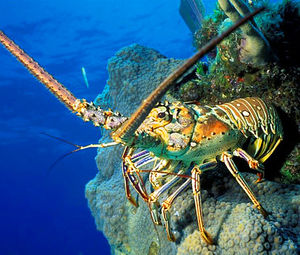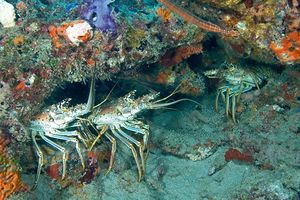SpinyLobster
Caribbean Spiny Lobster
Panulirus argus

Anatomy
Belonging to the arthropod phylum P. Argus has a segmented body design, a hard exoskeleton, jointed appendages and is an invertebrate. P. Argus is identifiable by their elongated cylindrical bodies with hard exoskeletons and forward facing spines which lend from the species' common name, Caribbean Spiny Lobster. P. Argus have biramous legs meaning that each leg branches off into two limbs and each branch attaches segments end to end ultimately terminating in a spiked point 1. Each of the somites on the ventral side of the abdomen is outfitted with swimmerets. These small black and yellow legs are used primarily for swimming, brooding eggs, and catching food and redirecting it toward the mouth and are found on many other arthropods 3. P. Argus large pinching claws found in other species of lobsters; however, they do possess a strong mandible that can crush mollusk shells for feeding 4. In terms of sexual dimorphism males have a slightly wider sternum than females, unlike their male counterparts female sternums are striated 2. A study conducted by Sarver, et al. studied mtDNA sequences of P. Argus from the Caribbean and the Brazilian coast to determine the genetic diversity in Spiny Lobsters from both locations in order to find whether they were genetically isolated from one another. It was experimentally determined that there was enough DNA sequence diversity to warrant the naming of two subspecies one being Panulirus argus argus which is found north of the equator and in the Caribbean and the other being Panulirus argus westonii which is found south of the equator in Brazil .
Biology

- Habitat: P. Argus are known to be found as in waters up to 100 meters deep as far north as the Outer banks of North Carolina and as far south as the coast of Brazil along the eastern coasts of North and South America. P Argus. can also be found throughout the Gulf of Mexico, the Bahamas, and the Caribbean 2. Since they are a nocturnal species and the prey of many predators such as Octopi, Sharks, Snappers and Groupers, P. Argus tends to choose a habitat with substantial cover in order to protect itself. This explains why P. Argus is found in and around coral reefs, sea grass beds, beach piers, and under mangrove roots since these habitats allow for a sustainable food source for P. Argus as well as ample protection from predators 4.
Threats
Other Names
References
1Gary C. B. Poore (2004). "Glossary". Marine Decapod Crustacea of Southern Australia: a Guide to Identification. CSIRO Publishing. p. 549–556
2J. L. Munro (1983). "The biology, ecology and bionomics of spiny lobsters (Palinuridae), apider crabs (Majidae) and other crustacean resources". In J. L. Munro. Caribbean Coral Reef Fishery Resources. ICLARM Technical Reports 7 (2nd ed.). The WorldFish Center. pp. 206–222.
3Lipke B. Holthuis (1991). "Panulirus argus". FAO Species Catalogue, Volume 13. Marine Lobsters of the World. FAO Fisheries Synopsis No. 125. Food and Agriculture Organization. pp. 133–134.
4Marx, J.M and W.F. Herrnkind. 1986. Species profiles: life histories and environmental requirements for coastal fish and invertebrates (South Florida), spiny lobster. Biol. Rep. 82(11.61).
5Sarver, S. K., J. D. Silberman, and P. J. Walsh. 1998. Mitochondrial DNA sequence evidence supporting the recognition of two subspecies or species of the Florida spiny lobster Panulirus argus. J. Crustacean Biology 18(1): 177–186.